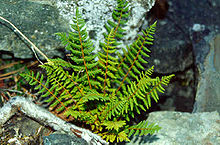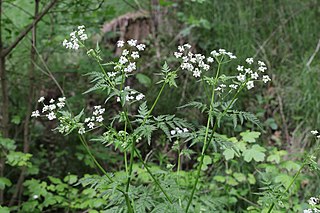
Anthriscus sylvestris, known as cow parsley, wild chervil, wild beaked parsley, Queen Anne's lace or keck, is a herbaceous biennial or short-lived perennial plant in the family Apiaceae (Umbelliferae). It is also sometimes called mother-die, a name that is also applied to the common hawthorn. It is native to Europe, western Asia and northwestern Africa. It is related to other diverse members of Apiaceae, such as parsley, carrot, hemlock and hogweed. It is often confused with Daucus carota, another member of the Apiaceae also known as "Queen Anne's lace" or "wild carrot".
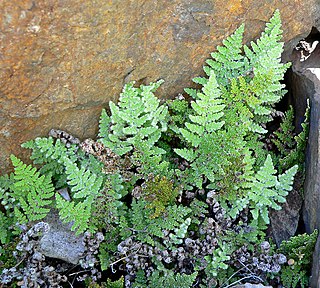
Myriopteris covillei, formerly known as Cheilanthes covillei, is a species of cheilanthoid fern known by the common name Coville's lip fern. Coville's lip fern is native to the southwestern United States and Mexico.
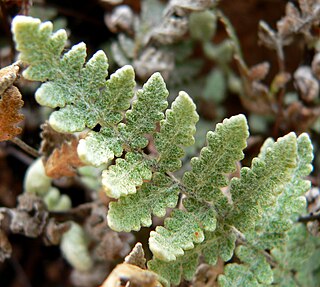
Myriopteris parryi, formerly known as Cheilanthes parryi, is a species of lip fern known by the common name Parry's lip fern.
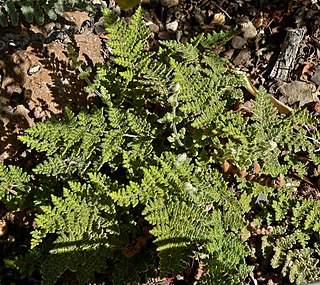
Myriopteris gracilis, formerly known as Cheilanthes feei, is a species of lip fern known by the common name slender lip fern or Fee's lip fern.

Aspidotis densa is a species of fern in the Cheilanthoid subfamily, known by the common name Indian's dream or Serpentine fern or dense lace fern. It is native to the west coast of North America from British Columbia to California and east to the Rocky Mountains in Idaho, Montana, and Wyoming; there is a disjunct population on serpentine soils in Quebec.

Campanula scabrella is a species of bellflower known by the common name rough bellflower. It is native to the mountains of the western United States, where it grows in talus and other rocky alpine habitat. This is a tough perennial herb growing in a clump from a woody rhizome and rarely exceeding 5 centimeters in height. The stiff leaves are linear to narrowly oval in shape and about 3 centimeters long, borne on winged petioles. The leaves are covered with very short appressed pale hairs. The small funnel-shaped flower is just under a centimeter long and pale blue or lavender in color, arising from the leaf clump on an erect pedicel about a centimeter tall.

Myriopteris gracillima, formerly known as Cheilanthes gracillima, is a species of lip fern known by the common name lace lip fern. It is native to western North America, where it grows in rocky habitat from British Columbia to California to Montana.

Myriopteris windhamii, formerly known as Cheilanthes villosa, is a species of lip fern, with the common name villous lipfern. It is native to the southwestern United States and Mexico.

Physematium scopulinum, also called Woodsia scopulina, is a deciduous perennial fern in the family Woodsiaceae, with the common name Rocky Mountain woodsia.
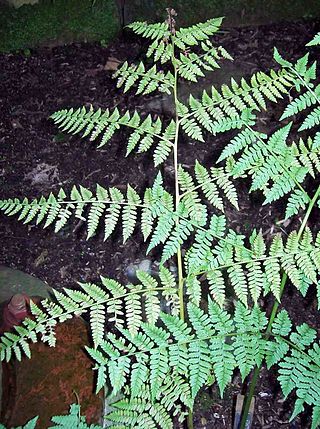
Diplazium australe, commonly known as the Austral lady fern, is a small fern occurring in eastern Australia, New Zealand and Norfolk Island. The habitat is moist shaded areas, often occurring in rainforest.

Adiantum viridimontanum, commonly known as Green Mountain maidenhair fern, is a fern found only in outcrops of serpentine rock in New England and Eastern Canada. The leaf blade is cut into finger-like segments, themselves once-divided, which are borne on the outer side of a curved, dark, glossy rachis. These finger-like segments are not individual leaves, but parts of a single compound leaf. The "fingers" may be drooping or erect, depending on whether the individual fern grows in shade or sunlight. Spores are borne under false indusia at the edge of the subdivisions of the leaf, a characteristic unique to the genus Adiantum.
Physematium neomexicanum, the New Mexican cliff fern, is a fern species native to the Southwestern United States and northern Mexico.

Balsamorhiza hookeri is a North American species of perennial plant in the family Asteraceae. It grows in the Great Basin and neighboring regions in the Western United States. It is found in Washington, Oregon, California, Idaho, Nevada, Utah, and Arizona.
Myriopteris aemula, the Texas lip fern or rival lip fern, is a moderately-sized fern of Texas and Mexico, a member of the family Pteridaceae. Unlike many members of its genus, its leaves have a few hairs on upper and lower surfaces, or lack them entirely. One of the cheilanthoid ferns, it was usually classified in the genus Cheilanthes as Cheilanthes aemula until 2013, when the genus Myriopteris was again recognized as separate from Cheilanthes. It typically grows on limestone rock.

Myriopteris aurea, the golden lip fern or Bonaire lip fern, is a moderately-sized fern native to the Americas, a member of the family Pteridaceae. Unlike many members of its genus, its leaf is only modestly dissected into lobed leaflets (pinnae), which are hairy both above and below. One of the cheilanthoid ferns, until 2013 it was classified in the genus Cheilanthes as Cheilanthes bonariensis, when the genus Myriopteris was again recognized as separate from Cheilanthes. It typically grows on dry, rocky slopes, and ranges from Mexico, where it is common and widespread, and the southwestern United States south and east through Central and South America as far as Chile and Argentina.

Polypodium amorphum is a species of fern with the common name irregular polypody, which grows near the northwest coast of North America.

Gymnocarpium disjunctum is a species of fern in the family Cystopteridaceae, commonly known as Pacific oak fern, western oak fern, or Pacific oakfern.
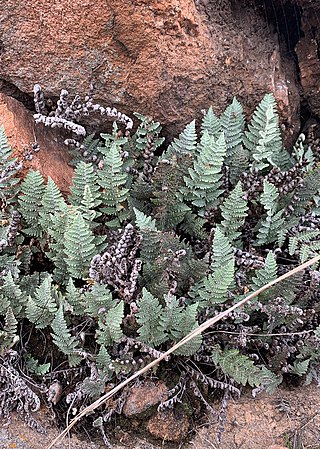
Myriopteris lindheimeri, formerly known as Cheilanthes lindheimeri, is a species of fern in the Pteridaceae family with the common name fairy swords.

Myriopteris yavapensis, formerly known as Cheilanthes yavapensis, is a species of cheilanthoid fern with the common name Yavapai lip fern native to the southwest United States.

Penstemon confertus is a species of flowering plant in the plantain family; its common name is the Yellow beardtoungue. It is native to the US states of Washington, Idaho, and Montana, and the Canadian provinces British Columbia and Alberta.
